Career
Easter Smith worked as an executive secretary in London, Paris, New York, and Sacramento, CA; an attaché spouse at the US Embassy in Paris; an Auction Coordinator at a PBS station; and as a newspaper reporter/editor in Plattsburgh, N.Y. She has also been a folk singer, and a community theater actor and director.
Her lifelong fascination with King Richard III led her to write six books set during the Wars of the Roses, featuring Richard and various members of his York family.
Easter Smith's first novel, A Rose for the Crown, has as its central theme the love story between Richard, while he was Duke of Gloucester and during the reign of his brother Edward IV, and the woman who gave birth to Richard's pre-marriage illegitimate children.
In her second novel, Easter Smith focuses on Margaret of York, Richard and Edward's sister, who, like all royals of the time, anticipates a marriage negotiated for political advantage. Margaret is wedded to Charles the Bold, ruler of the Duchy of Burgundy, the wealthiest in Europe. Daughter of York tells the story of Margaret's early life in England, her lavish wedding to Charles, and both her personal and public life in Burgundy's leading cities, which at the time included Bruges, Binche, and Mechelen, among others.
Easter Smith's third novel, The King's Grace, explores the identity of Perkin Warbeck, a pretender to the throne, through the eyes of Grace Plantagenet, an illegitimate daughter of King Edward IV. Her fourth novel, Queen by Right, reveals the long and colorful life of Cecily Neville, mother of Edward IV and Richard III.
Royal Mistress, the author's fifth novel, features the life of Jane Shore, the favorite and final mistress of Edward IV.
Easter Smith's sixth novel, This Son of York, is the story of Richard III.

Elizabeth "Jane" Shore was one of the many mistresses of King Edward IV of England. She became the best-known to history through being later accused of conspiracy by the future King Richard III, and compelled to do public penance. She was also a sometime mistress of other noblemen, including Edward's stepson, Thomas Grey, 1st Marquess of Dorset, and William Hastings, 1st Baron Hastings but ended her life in bourgeois respectability.

Perkin Warbeck was a pretender to the English throne claiming to be Richard of Shrewsbury, Duke of York, who was the second son of Edward IV and one of the so-called "Princes in the Tower". Richard, were he alive, would have been the rightful claimant to the throne, assuming that his elder brother Edward V was dead and that he was legitimate—a point that had been previously contested by his uncle, King Richard III.

Edward IV was King of England from 4 March 1461 to 3 October 1470, then again from 11 April 1471 until his death in 1483. He was a central figure in the Wars of the Roses, a series of civil wars in England fought between the Yorkist and Lancastrian factions between 1455 and 1487.

Henry VI was King of England from 1422 to 1461 and again from 1470 to 1471, and disputed King of France from 1422 to 1453. The only child of Henry V, he succeeded to the English throne at the age of nine months upon his father's death, and succeeded, disputedly, to the French throne on the death of his maternal grandfather, Charles VI, shortly afterwards.

Elizabeth Woodville, later known as Dame Elizabeth Grey, was Queen of England from her marriage to King Edward IV on 1 May 1464 until Edward was deposed on 3 October 1470, and again from Edward's resumption of the throne on 11 April 1471 until his death on 9 April 1483. She was a key figure in the Wars of the Roses, a dynastic civil war between the Lancastrian and the Yorkist factions between 1455 and 1487.
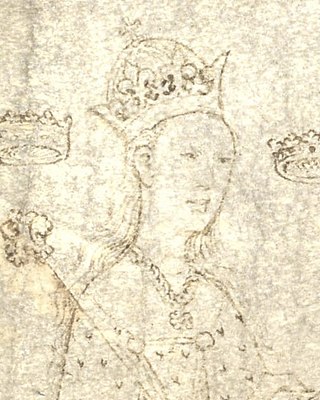
Anne Neville was Queen of England as the wife of King Richard III. She was the younger of the two daughters and co-heiresses of Richard Neville, 16th Earl of Warwick. Before her marriage to Richard, she had been Princess of Wales as the wife of Edward of Westminster, Prince of Wales, the only son and heir apparent of King Henry VI.

The Princes in the Tower refers to the mystery of the fate of the deposed King Edward V of England and his younger brother Prince Richard of Shrewsbury, Duke of York, heirs to the throne of King Edward IV of England. The brothers were the only sons of the king by his queen, Elizabeth Woodville, living at the time of their father's death in 1483. Aged 12 and 9 years old, respectively, they were lodged in the Tower of London by their paternal uncle and England's regent, Richard, Duke of Gloucester, supposedly in preparation for Edward V's forthcoming coronation. Before the young king could be crowned, however, he and his brother were declared illegitimate. Gloucester ascended the throne as Richard III.

Margaret of York, also known by marriage as Margaret of Burgundy, was Duchess of Burgundy as the third wife of Charles the Bold and acted as a protector of the Burgundian State after his death. She was a daughter of Richard, 3rd Duke of York, and Cecily Neville, and the sister of two kings of England, Edward IV and Richard III. She was born at Fotheringhay Castle, Northamptonshire, in the Kingdom of England, and she died at Mechelen in the Low Countries.
Lady Eleanor Talbot, also known by her married name Eleanor Butler, was an English noblewoman. She was a daughter of John Talbot, 1st Earl of Shrewsbury. After the death of Edward IV of England in 1483 it was claimed by Robert Stillington, Bishop of Bath and Wells, that she had had a legal precontract of marriage to Edward, which invalidated the king's later marriage to Elizabeth Woodville. According to Richard, Duke of Gloucester, this meant he, rather than Edward's sons, was the true heir to the throne. Richard took the crown and imprisoned Edward's sons, who subsequently disappeared.
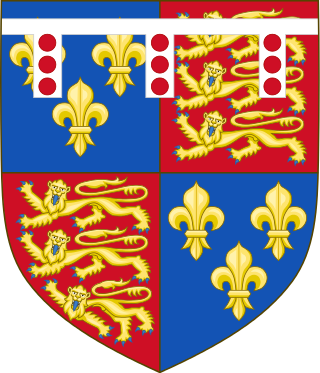
The House of York was a cadet branch of the English royal House of Plantagenet. Three of its members became kings of England in the late 15th century. The House of York descended in the male line from Edmund of Langley, 1st Duke of York, the fourth surviving son of Edward III. In time, it also represented Edward III's senior line, when an heir of York married the heiress-descendant of Lionel, Duke of Clarence, Edward III's second surviving son. It is based on these descents that they claimed the English crown. Compared with its rival, the House of Lancaster, it had a superior claim to the throne of England according to cognatic primogeniture, but an inferior claim according to agnatic primogeniture. The reign of this dynasty ended with the death of Richard III of England at the Battle of Bosworth Field in 1485. It became extinct in the male line with the death of Edward Plantagenet, 17th Earl of Warwick, in 1499.

John Howard, 1st Duke of Norfolk, also known as Jack of Norfolk,, was an English nobleman, soldier, politician, and the first Howard Duke of Norfolk. He was a close friend and loyal supporter of King Richard III, with whom he was slain at the Battle of Bosworth in 1485.

Cecily Neville was an English noblewoman, the wife of Richard, Duke of York (1411–1460), and the mother of two kings of England—Edward IV and Richard III. Cecily Neville was known as "the Rose of Raby", because she was born at Raby Castle in Durham, and "Proud Cis", because of her pride and a temper that went with it, although she was also known for her piety. She herself signed her name "Cecylle".
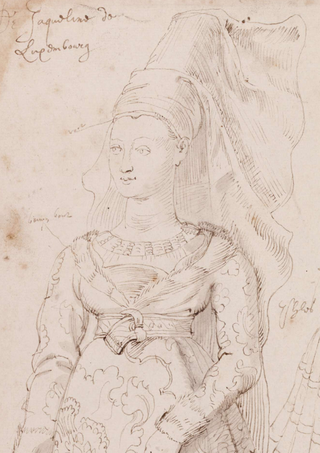
Jacquetta of Luxembourg was a prominent, though often overlooked, figure in the Wars of the Roses. Through her short-lived first marriage to the Duke of Bedford, brother of King Henry V, she was firmly allied to the House of Lancaster. However, following the emphatic Lancastrian defeat at the Battle of Towton, she and her second husband Richard Woodville sided closely with the House of York. Three years after the battle and the accession of Edward IV of England, Jacquetta's eldest daughter Elizabeth Woodville married him and became queen consort of England. Jacquetta bore Woodville 14 children and stood trial on charges of witchcraft, of which she was exonerated.

The House of Plantagenet was a royal house which originated in the French County of Anjou. The name Plantagenet is used by modern historians to identify four distinct royal houses: the Angevins, who were also Counts of Anjou; the main line of the Plantagenets following the loss of Anjou; and the houses of Lancaster and York, the Plantagenets' two cadet branches. The family held the English throne from 1154, with the accession of Henry II, until 1485, when Richard III died.
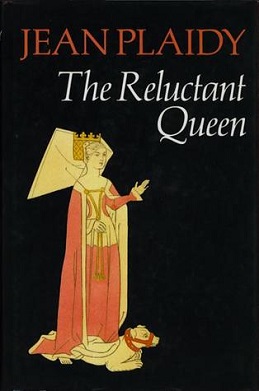
The Reluctant Queen is a novel by historical novelist Jean Plaidy which tells the tale of Anne Neville, the wife of King Richard III of England. It weaves the tale of Anne's life told in first person. The book was published in the US as The Reluctant Queen: The Story of Anne of York
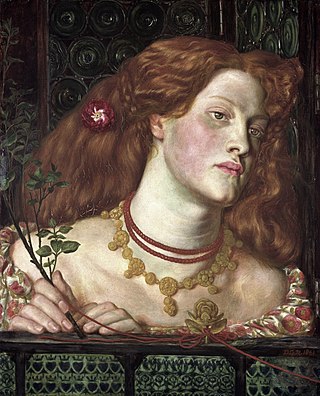
In the English or British court, a royal mistress is a woman who is the lover of a member of the royal family; specifically, the king. She may be taken either before or after his accession to the throne. Although it generally is only used of females, by extrapolation, the relation can cover any lover of the monarch, whether male or female. Queen Elizabeth I is said to have had many male favorites, including Robert Dudley, 1st Earl of Leicester, although it is not known whether the relationships were sexual or not.
Edward IV of England has been depicted in popular culture a number of times.
Margaret Stewart was the younger daughter of James II of Scotland and Mary of Guelders. Once engaged to the Lancastrian Prince of Wales, Margaret instead became the mistress of William Crichton, 3rd Lord Crichton, and the mother of his illegitimate daughter, Margaret Crichton, later Countess of Rothes, and possibly his son, Sir James Crichton, progenitor of the Viscounts of Frendraught. Margaret and Lord Crichton may have been married later, after the death of Crichton's wife.

A royal bastard is a child of a reigning monarch born out of wedlock. The king might have a child with a mistress, or the legitimacy of a marriage might be questioned for reasons concerning succession.
Elizabeth Lucy, also known as Lady Lucy, Lady Elizabeth, and Elizabeth Wayte, daughter of Thomas Wayte of Hamptonshire, was the possible mistress of King Edward IV of England, and possible mother of several children by him, including Arthur Plantagenet, 1st Viscount Lisle. Arthur was known in his youth as Arthur Wayte. He was elevated to the title, Viscount Lisle, by Henry Tudor.















